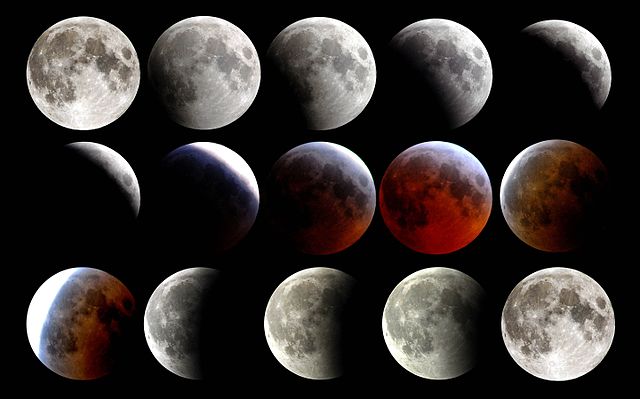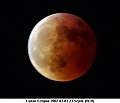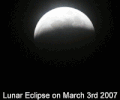March 2007 lunar eclipse
| Total Lunar Eclipse 3–4 March 2007 | |
|---|---|
 The moon in the northern part of the Earth's umbral shadow during totality at 23:31 UTC from Denmark | |
 The moon's path through the Earth's northern shadow. | |
| Series (and member) | 123 (57 of 73) |
| Gamma | 0.31749 |
| Magnitude | 1.23280 |
| Duration (hr:mn:sc) | |
| Totality | 1:13:21 |
| Partial | 3:41:04 |
| Penumbral | 6:05:26 |
| Contacts (UTC) | |
| P1 | 20:18:11 (3 Mar) |
| U1 | 21:30:20 (3 Mar) |
| U2 | 22:44:12 (3 Mar) |
| Greatest | 23:20:53 (3 Mar) |
| U3 | 23:57:33 (3 Mar) |
| U4 | 01:11:24 (4 Mar) |
| P4 | 02:23:37 (4 Mar) |
 The moon's hourly motion across the Earth's shadow in the constellation of Leo | |
A total lunar eclipse took place on 3 March 2007, the first of two eclipses in 2007. The moon entered the penumbral shadow at 20:18 UTC, and the umbral shadow at 21:30 UTC. The total phase lasted between 22:44 UTC and 23:58 UTC with a distinctive brick-red shade (L=3 to L=4 on the Danjon scale). The moon left the umbra shadow at 01:11 UTC and left the penumbra shadow at 02:24 UTC 2007-03-04. The second lunar eclipse of 2007 occurred on 28 August.
Eclipse Season[]
This is the first eclipse this season.
Second eclipse this season: 19 March 2007 Partial Solar Eclipse
Lunar eclipses[]
The previous lunar eclipse on 7 September 2006 was partial.
This eclipse is the first of two lunar eclipses to occur in 2007, the second being on 28 August 2007. The tables below contain detailed predictions and additional information on the Total Lunar Eclipse of 3 March 2007.
Penumbral Magnitude = 2.31882
Umbral Magnitude = 1.23280
Gamma = 0.31749
Greatest Eclipse = 03 Mar 2007 23:20:53.5 UTC (23:21:58.7 TD)
Sun right ascension = 22 hours, 57 minutes, 19.2 seconds
Sun declination = 6 degrees, 40 minutes, 46.3 seconds south of Celestial Equator
Sun diameter = 1936.0 arcseconds
Moon right ascension = 10 hours, 57 minutes, 52.2 seconds
Moon declination = 6 degrees, 56 minutes, 0.7 seconds north of Celestial Equator
Moon diameter = 1782.6 arcseconds
Earth's shadow right ascension = 10 hours, 57 minutes, 19.2 seconds
Earth's shadow declination = 6 degrees, 40 minutes, 46.3 seconds north of Celestial Equator
Totality duration = 1 hour, 13 minutes, 21.3 seconds
Umbral duration = 3 hours, 41 minutes, 5.6 seconds
Total duration = 6 hours, 5 minutes, 31.3 seconds
Viewing[]
The whole event was visible from Europe, Africa, parts of South America, and some areas of North America, Asia, and Western Australia. In North America, part of the event was visible at moonrise.
 This simulated view of the earth from the center of the moon during the lunar eclipse shows where the eclipse is visible on earth. |
Map[]


Relation to other lunar eclipses[]
Eclipses of 2007[]
- A total lunar eclipse on 3 March.
- A partial solar eclipse on 19 March.
- A total lunar eclipse on 28 August.
- A partial solar eclipse on 11 September.
Lunar year series[]
| Lunar eclipse series sets from 2006–2009 | ||||||||
|---|---|---|---|---|---|---|---|---|
| Descending node | Ascending node | |||||||
| Saros # and photo |
Date Viewing |
Type Chart |
Gamma | Saros # and photo |
Date Viewing |
Type Chart |
Gamma | |
113
|
2006 Mar 14
|
penumbral
|
1.0211 | 118
|
2006 Sep 7
|
partial
|
-0.9262 | |
123
|
2007 Mar 03
|
total
|
0.3175 | 128
|
2007 Aug 28
|
total
|
-0.2146 | |
133
|
2008 Feb 21
|
total
|
-0.3992 | 138
|
2008 Aug 16
|
partial
|
0.5646 | |
143
|
2009 Feb 09
|
penumbral
|
-1.0640 | 148
|
2009 Aug 06
|
penumbral
|
1.3572 | |
| Last set | 2005 Apr 24 | Last set | 2005 Oct 17 | |||||
| Next set | 2009 Dec 31 | Next set | 2009 Jul 07 | |||||
Metonic cycle (19 years)[]
The Metonic cycle repeats nearly exactly every 19 years and represents a Saros cycle plus one lunar year. Because it occurs on the same calendar date, the earth's shadow will be in nearly the same location relative to the background stars.
|
|

|

|
Saros series[]
Lunar saros series 123, repeating every 18 years and 11 days, has 25 total lunar eclipses. The first total lunar eclipse of this series was on , and last will be on . The two longest occurrence of this series were on and when totality lasted 106 minutes.
It last occurred on 20 February 1989 and will next occur on 14 March 2025.
Half-Saros cycle[]
A lunar eclipse will be preceded and followed by solar eclipses by 9 years and 5.5 days (a half saros).[1] This lunar eclipse is related to two total solar eclipses of Solar Saros 130.
| 26 February 1998 | 9 March 2016 |
|---|---|

|

|
Photo gallery[]
 From Leeds, England. | |
 Stevenage, England | |
 From Madrid, Spain | |
 From Degania A, Israel. | |
 Persian Gulf |
From Kirchberg, St. Gallen, 23:30 UTC

From Huddersfield, UK, 23:52 UTC

From Augsburg, Germany, 23:53 UTC

From Huddersfield, UK, 0:01 UTC
From Kirchberg, St. Gallen, 0:15 UTC
From Cambridge, UK

Timelapse movie in Bülach, Switzerland

Timelapse movie in Belfort, France

Humacao, Puerto Rico, 07:43 EST

Humacao, Puerto Rico, 08:30:16 EST
See also[]
- List of lunar eclipses and List of 21st-century lunar eclipses
Notes[]
- ^ Mathematical Astronomy Morsels, Jean Meeus, p.110, Chapter 18, The half-saros
External links[]
- 2007 Mar 03 chart: Eclipse Predictions by Fred Espenak, NASA/GSFC
- Hermit eclipse: Total lunar eclipse: March 3, 2007
- NASA Saros series 123
- Photos
- Photos from the Netherlands lunar eclipse 3 March
- Flickr: Lunar Eclipse 3/3/2007: pictures of the eclipse, many of which CC-licensed, from Flickr members
- Live webcast of the total lunar eclipse 3/4 March 2007 by Astronet (The Netherlands, Belgium, Spain)
- Video of the March 3, 2007 eclipse as seen from the UK
- Lunar Eclipse 3/3/2007
- Animated sequence
- photo
| Wikimedia Commons has media related to Lunar eclipse of 2007 March 3. |
| Wikinews has related news: |
- Lunar eclipse templates
- 21st-century lunar eclipses
- 2007 in science
- March 2007 events












